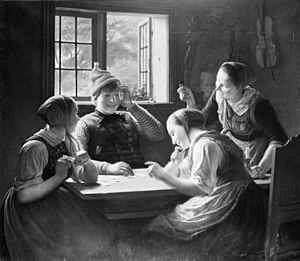Black Peter (card game) facts for kids
| Popular European children's game | |

Black Peter cards from a 1920 J. W. Spear & Sons deck
|
|
| Origin | Germany |
|---|---|
| Alternative name | Schwarzer Peter |
| Type | Shedding |
| Players | 3 or more |
| Age range | 6+ |
| Cards | 31 or 37 |
| Deck | Special or standard packs |
| Play | Clockwise |
| Playing time | 5-10 minutes |
| Random chance | Easy |
| Related games | |
| Old Maid, Vieux Garçon | |
Black Peter is a fun and popular children's card game played across Europe. It started in Germany, where it's known as Schwarzer Peter. It's one of the most common card games for kids there, similar to Quartett.
Contents
What's in a Name?
The name Black Peter might come from a person named Johann Peter Petri. He was known as "Old Black Peter" (der alte Schwarzpeter). Some stories say he invented the game while he was in prison after 1811. However, the game's true beginnings are probably much older than that!
Game History
The exact start of Black Peter isn't fully clear. Rules for games like it were written down as early as 1821. This was even before similar games like the English Old Maid (first known rules in 1884) or the French Vieux Garçon ("Old Boy," first recorded in 1853).
These games likely began a long time ago. They might have been simple ways to decide who would pay for the next round of something. For example, in Old Maid, a special pack of 32 French cards is used. The Queen of Hearts is removed. In Vieux Garçon, one of the Jacks is taken out. The player left holding the single Queen or Jack at the end was the "old maid" or "vieux garçon."
Black Peter has been a favorite children's game for a long time. Today, you can find many special card packs made just for kids. In older card sets, the "Black Peter" card often showed a specific image. Modern packs use different pictures, like chimney sweeps, black crows, or black cats.
How to Play Black Peter
Special Black Peter card packs usually have 31 or 37 cards. This includes one "Black Peter" card and 15 or 18 pairs of matching cards. You can also use a regular pack of playing cards. Just add a Joker as the Black Peter, or remove one card to make an incomplete pair.
Getting Started
- Any number of players can join, but you need at least two.
- First, shuffle all the cards well.
- Then, deal out all the cards to the players. Everyone should have some cards.
- Look at your hand. If you have any matching pairs, put them down right away.
Playing the Game
- Now, the card drawing begins!
- The youngest player, or the player with the most cards, or the player to the left of the dealer starts.
- This player draws one card from the player to their left.
- Add the new card to your hand. If you can make a pair with it, put that pair down.
- Then, it's the turn of the player to your left to do the same thing.
- The game continues like this. Players keep drawing cards and discarding pairs.
- Eventually, all the pairs will be gone. One player will be left holding only the Black Peter card.
- That player is the "Black Peter" and gets a fun, agreed-upon penalty. This might be a black dot on their forehead, nose, or cheek!
Black Peter Around the World
This game is known by different names in other countries:
- In Italy, children play Asinello, which means "little donkey."
- In Sweden, it's called Svarte Petter.
- In Finland, it's Musta Pekka.
- In Denmark, it's Sorteper.
- In the Netherlands, it's zwartepieten ("playing Black Pete") or pijkezotjagen ("Chasing the jack of spades").
- In Polish, it's Piotruś ("Peter").
- In Icelandic, it's Svarti Pétur ("black Peter").
- In Czech, it's Černý Petr ("black Peter").
- In Greek, it's "mu(n)tzuris" (μου(ν)τζούρης), meaning "smudged" or "smutted."
A Common Saying
In Germany, there's a saying related to the game: "jemandem den Schwarzen Peter zuschieben." This means "to pass the Black Peter to someone." It's used when someone tries to blame another person or give them an unwanted problem or responsibility.
Images for kids




